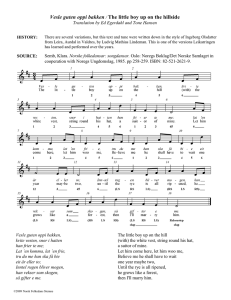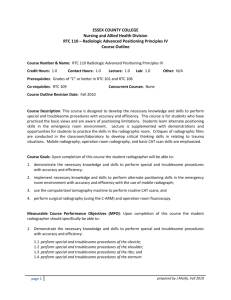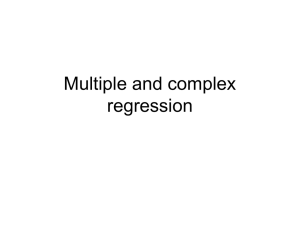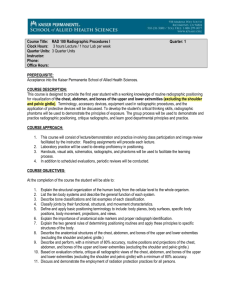rtc.101.outline.f2010 - Student Learning Outcomes (SLO)
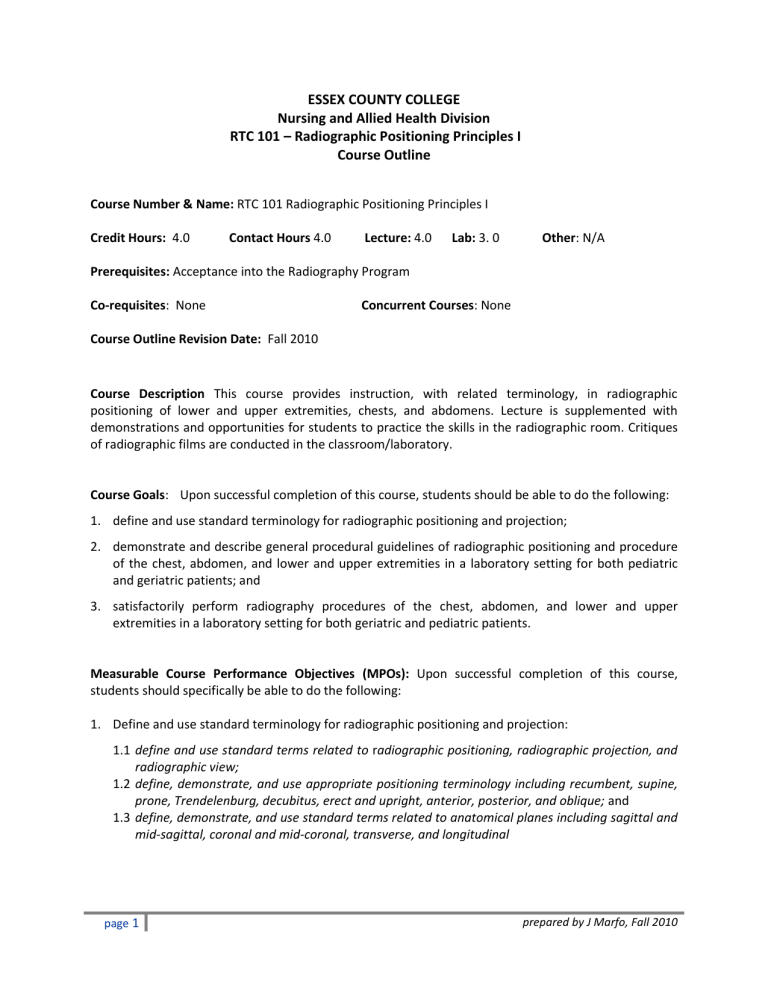
ESSEX COUNTY COLLEGE
Nursing and Allied Health Division
RTC 101 – Radiographic Positioning Principles I
Course Outline
Course Number & Name: RTC 101 Radiographic Positioning Principles I
Credit Hours: 4.0 Contact Hours 4.0 Lecture: 4.0 Lab: 3. 0
Prerequisites: Acceptance into the Radiography Program
Co-requisites: None Concurrent Courses: None
Course Outline Revision Date: Fall 2010
Other: N/A
Course Description This course provides instruction, with related terminology, in radiographic positioning of lower and upper extremities, chests, and abdomens. Lecture is supplemented with demonstrations and opportunities for students to practice the skills in the radiographic room. Critiques of radiographic films are conducted in the classroom/laboratory.
Course Goals: Upon successful completion of this course, students should be able to do the following:
1. define and use standard terminology for radiographic positioning and projection;
2. demonstrate and describe general procedural guidelines of radiographic positioning and procedure of the chest, abdomen, and lower and upper extremities in a laboratory setting for both pediatric and geriatric patients; and
3. satisfactorily perform radiography procedures of the chest, abdomen, and lower and upper extremities in a laboratory setting for both geriatric and pediatric patients.
Measurable Course Performance Objectives (MPOs): Upon successful completion of this course, students should specifically be able to do the following:
1. Define and use standard terminology for radiographic positioning and projection:
1.1 define and use standard terms related to radiographic positioning, radiographic projection, and radiographic view;
1.2 define, demonstrate, and use appropriate positioning terminology including recumbent, supine,
prone, Trendelenburg, decubitus, erect and upright, anterior, posterior, and oblique; and
1.3 define, demonstrate, and use standard terms related to anatomical planes including sagittal and mid-sagittal, coronal and mid-coronal, transverse, and longitudinal page 1 prepared by J Marfo, Fall 2010
Measurable Course Performance Objectives (MPOs) (continued):
2. Demonstrate and describe general procedural guidelines of radiographic positioning and procedure of the chest, abdomen, and lower and upper extremities in a laboratory setting for both pediatric and geriatric patients:
2.1 demonstrate and describe patient preparation;
2.2 demonstrate and describe general patient position;
2.3 discuss IR size;
2.4 discuss SID;
2.5 demonstrate and identify ID markers;
2.6 demonstrate and discuss radiation protection; and
2.7 discuss patient instructions
3. Satisfactorily perform radiography procedures of the chest, abdomen, and lower and upper extremities in a laboratory setting for both geriatric and pediatric patients:
3.1 satisfactorily perform radiography procedures of the chest for a geriatric patient;
3.2 satisfactorily perform radiography procedures of the abdomen for a geriatric patient;
3.3 satisfactorily perform radiography procedures of the lower extremities for a geriatric patient;
3.4 satisfactorily perform radiography procedures of the upper extremities for a geriatric patient;
3.5 satisfactorily perform radiography procedures of the chest for a pediatric patient;
3.6 satisfactorily perform radiography procedures of the abdomen for a pediatric patient;
3.7 satisfactorily perform radiography procedures of the lower extremities for a pediatric patient; and
3.8 satisfactorily perform radiography procedures of the upper extremities for a pediatric patient
Method of Instruction; Instruction will consist of lectures, labs demonstrations, discussions, PowerPoint presentations, and film critique (radiograph review). Students will utilize such resources as mannequins, skeletons, loose bones, phantom radiographs, audio-visual materials, the internet, and the computer lab.
Outcomes Assessment: Quiz and exam questions are blueprinted to the course objectives which are based on the minimum standards required by the American Radiology of Radiologic Technologists
(ARRT) and the American Society of Radiologic Technologists (ASRT) required course curriculum. N OTE :
Testing is primarily structured in multiple choice formats in conjunction with the ARRT exam. Rubrics are used to evaluate lab performance of students for the presence and mastery level of course objectives. page 2 prepared by J Marfo, Fall 2010
Course Requirements: All students are required to:
1. Attend class. Attendance is mandatory for successful completion of this course.
2. Be in class on time for quiz and exam days. Students arriving late on the day of a quiz or exam will forfeit the benefit of the entire allotted time and must complete the task in only the time remaining.
There will be NO make-up quizzes or exams.
3. Turn off all cell phones during class.
4. Remain in the classroom during the entire class period.
5. Earn a “C” or better to pass this course. Students that do not earn a “C” or better will be required to withdraw from the Radiography Program per Radiography Program policy.
Methods of Evaluation: Final course grades will be computed as follows:
% of
final course grade Grading Components
4 or more Quizzes (dates specified by the instructor)
Quizzes will be administered regularly throughout the semester
20% to test student mastery of course objectives. N OTE : The lowest quiz grade will be dropped and the remaining 3 highest quiz grades will be averaged to provide a Quiz Average, which counts as 20% of the final course grade.
Laboratory Proficiency Exam
Laboratory experiences are designed to prepare students to perform radiographs of the chest, abdomen, lower extremities, and upper extremities with both pediatric and geriatric patients.
20%
The laboratory proficiency exam will provide evidence of the extent of student achievement of some course goals. (See
Flowsheet for Laboratory Proficiency Exam on pages 6 – 7.)
Midterm Exam (date specified by the instructor)
The midterm exam format may consist of multiple choice, short answer, and true/false questions and will include material from the readings, homework, lectures, and labs covered throughout
20% the semester. The midterm exam will test the students’ mastery of course objectives and synthesis of course material covered
from the beginning through the first half of the semester.
Final Exam
The final exam format may consist of multiple choice, short answer, and true/false questions and will include material from the readings, homework, lectures, and labs covered throughout the semester. The final exam will test the students’ mastery of course objectives and synthesis of course material covered throughout the entire semester.
40% page 3 prepared by J Marfo, Fall 2010
N OTE : Laboratory attendance in RTC 101 is mandatory. Participation and the lack thereof will have a considerable effect on the overall grade calculations. Failure to show interest in lab class, can demonstrate difficulty with the material or boredom. It is important to keep in mind that any knowledge students obtain in respect to individual instructors is unique. Initial Laboratory Competencies are graded as per Clinical Competency Examination Sheets. Each student is provided two opportunities to successfully complete his/her Initial Laboratory Competencies. If the second attempt is unsuccessful the student will receive a numerical grade of zero.
Academic Integrity: Dishonesty disrupts the search for truth that is inherent in the learning process and so devalues the purpose and the mission of the College. Academic dishonesty includes, but is not limited to, the following:
plagiarism – the failure to acknowledge another writer’s words or ideas or to give proper credit to sources of information;
cheating – knowingly obtaining or giving unauthorized information on any test/exam or any other academic assignment;
interference – any interruption of the academic process that prevents others from the proper engagement in learning or teaching; and
fraud – any act or instance of willful deceit or trickery.
Violations of academic integrity will be dealt with by imposing appropriate sanctions. Sanctions for acts of academic dishonesty could include the resubmission of an assignment, failure of the test/exam, failure in the course, probation, suspension from the College, and even expulsion from the College.
Student Code of Conduct: All students are expected to conduct themselves as responsible and considerate adults who respect the rights of others. Disruptive behavior will not be tolerated. All students are also expected to attend and be on time for all class meetings. No cell phones or similar electronic devices are permitted in class. Please refer to the Essex County College student handbook,
Lifeline, for more specific information about the College’s Code of Conduct and attendance requirements. page 4 prepared by J Marfo, Fall 2010
Course Content Outline: based on the text Textbook of Radiographic Positioning and Related
Anatomy, 7 th edition, by Kenneth L Bontrager; ISBN #: 978-0-323-05410
Week Topics covered
1 – 2
Chapter 1, pp 14 – 33
Assignment: Hand out from the instructor
3 – 4 Quiz 1 on standard terminologies
Chest
Chapter 3, pp 70 – 101
5
Review class syllabus, project due dates
Standard terminologies for positions and projections
6 – 8
Quiz 2 on chest
Abdomen
Chapter 4, pp 103 – 122
Upper extremities
Midterm Exam (in week 7 on chest & abdomen)
Chapter 5, pp 123 – 170 and Chapter 6, pp 171 – 203
9 – 11 Quiz 3 on upper extremities
Lower extremities
Chapter 7, pp 205 – 257 and Chapter 8, pp 260 – 285
12
13
14
Quiz 4 on lower extremities
Hip/pelvis
Bone age/bone length
Text, pp 338 – 341 & 769
Pediatric radiography
Text, pp 657 – 678
Review for Final Exam
15 Final Exam page 5 prepared by J Marfo, Fall 2010
1A Chest
FLOW
‐
SHEET FOR
LABORATORY PROFICIENCY EXAMINATION
RTC 101
# BODY PART
1 Chest
POSITION(S) REQUIRED
Routine (PA/LAT)
Lordotic (special view)
Stretcher/wheelchair
(AP)
VIEWS
2
1
1
1B Chest Decubitus or obliques 4
1C Pediatric Chest
2A Abdomen
2B Abdomen
2C Pediatric Abdomen
2D
Pediatric soft tissue – neck
3 Fingers
4 Hand
5 Wrist
6
Radius/ulna
(forearm)
7 Elbow
7A Elbow
8 Humerus
8A Humerus
9 Clavicle
10 Shoulder
AP/LAT
AP (KUB)/Erect
Dorsal/Decubitus/LAT Decubitus
AP/LAT/Erect
AP/LAT
PA entire hand
AP/LAT thumb
LAT/OBL digits
PA/OBL/FAN LAT or True LAT
PA/LAT/OBL/ULNA DEV/CARPAL CANNAL/Scaphoid
AP/LAT
AP/LAT/both OBL
Partial flexion (trauma), axial trauma (Coyle view)
AP/LAT (recumbent or upright) non-trauma
AP NEUTRAL/Transthorasic (trauma)
AP/AP 15 – 30 degrees cephlad or PA 15 – 30 degrees caudad
Internal/external/neutral/non-trauma
Posterior OBL (Grashey) or tangential non-trauma
4
3
2
2
2
5
2
4
3
3
4
2
2
2
4 page 6 prepared by J Marfo, Fall 2010
# BODY PART
10A Shoulder trauma
11 Scapula
12 AC Joint
13 Pediatric
14 Toes
15 Foot
16 Foot
17 Ankle
POSITION(S) REQUIRED
AP NEUTRAL
Transthoracic LAT
SCAPULAR Y-view trauma
(Lawrence Method)
AP
PA LAT OBL
Scapular Y- trauma
AP with & without weight bearing
AP/LAT entire infant arm
AP entire foot/LAT OBL toe or OBL/LAT 1 st – 5 th
AP/LAT/mediolateral OBL
AP/LAT weight bearing
AP/LAT/OBL/ankle mortise
18 Calcaneus AP/plantodorsal or AP dorsoplantar axial
19 Tibia/fibula (lower leg) AP/LAT
20
21
22
Knee
Knee
Patella
AP/LAT/both OBL
PA/PA axial intercondylar fossa
HOMLAD/COMP COVENTRY/BECLERE
PA/LAT
Supine flexion 45 degrees (Merchant view)
Prone flexion 90 degrees (Settegast)
Prone flexion 55 degrees (Hughston view)/tangential
AP/LAT 23 Femur
24 Trauma lower extremity AP/LAT ankle (ankle position 45 degrees)
Entire lower extremity AP/ LAT 25 Pediatric page 7
VIEWS
3
2
4
2
2
2 prepared by J Marfo, Fall 2010
3
2
4
2
2
3
2
2
4
4


